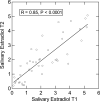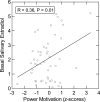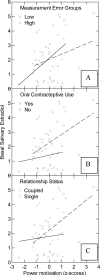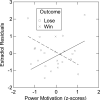Basal and dynamic relationships between implicit power motivation and estradiol in women
- PMID: 17949722
- PMCID: PMC8382952
- DOI: 10.1016/j.yhbeh.2007.07.002
Basal and dynamic relationships between implicit power motivation and estradiol in women
Abstract
This study investigated basal and reciprocal relationships between implicit power motivation (n Power), a preference for having impact and dominance over others, and both salivary estradiol and testosterone in women. 49 participants completed the Picture Story Exercise, a measure of n Power. During a laboratory contest, participants competed in pairs on a cognitive task and contest outcome (win vs. loss) was experimentally varied. Estradiol and testosterone levels were determined in saliva samples collected at baseline and several times post-contest, including 1 day post-contest. n Power was positively associated with basal estradiol concentrations. The positive correlation between n Power and basal estradiol was stronger in single women, women not taking oral contraceptives, or in women with low-CV estradiol samples than in the overall sample of women. Women's estradiol responses to a dominance contest were influenced by the interaction of n Power and contest outcome: estradiol increased in power-motivated winners but decreased in power-motivated losers. For power-motivated winners, elevated levels of estradiol were still present the day after the contest. Lastly, n Power and estradiol did not correlate with self-reported dominance and correlated negatively with self-reported aggression. Self-reported dominance and aggression did not predict estradiol changes as a function of contest outcome. Overall, n Power did not predict basal testosterone levels or testosterone changes as a function of dominance contest outcome.
Figures





Similar articles
-
Endocrine and aggressive responses to competition are moderated by contest outcome, gender, individual versus team competition, and implicit motives.PLoS One. 2017 Jul 27;12(7):e0181610. doi: 10.1371/journal.pone.0181610. eCollection 2017. PLoS One. 2017. PMID: 28750061 Free PMC article.
-
Effects of implicit power motivation on men's and women's implicit learning and testosterone changes after social victory or defeat.J Pers Soc Psychol. 2005 Jan;88(1):174-88. doi: 10.1037/0022-3514.88.1.174. J Pers Soc Psychol. 2005. PMID: 15631583
-
Implicit power motivation moderates men's testosterone responses to imagined and real dominance success.Horm Behav. 1999 Dec;36(3):234-41. doi: 10.1006/hbeh.1999.1542. Horm Behav. 1999. PMID: 10603287
-
The dominance behavioral system and psychopathology: evidence from self-report, observational, and biological studies.Psychol Bull. 2012 Jul;138(4):692-743. doi: 10.1037/a0027503. Epub 2012 Apr 16. Psychol Bull. 2012. PMID: 22506751 Free PMC article. Review.
-
Voice pitch: a window into the communication of social power.Curr Opin Psychol. 2020 Jun;33:154-161. doi: 10.1016/j.copsyc.2019.07.028. Epub 2019 Jul 21. Curr Opin Psychol. 2020. PMID: 31445439 Review.
Cited by
-
The role of the dorsoanterior striatum in implicit motivation: the case of the need for power.Front Hum Neurosci. 2013 Apr 19;7:141. doi: 10.3389/fnhum.2013.00141. eCollection 2013. Front Hum Neurosci. 2013. PMID: 23626531 Free PMC article.
-
Within-person coupling of estradiol, testosterone, and cortisol in women athletes.PeerJ. 2020 Jan 24;8:e8402. doi: 10.7717/peerj.8402. eCollection 2020. PeerJ. 2020. PMID: 32002332 Free PMC article.
-
The effects of power posing on neuroendocrine levels and risk-taking.BMC Psychol. 2024 Dec 5;12(1):726. doi: 10.1186/s40359-024-02194-7. BMC Psychol. 2024. PMID: 39633430 Free PMC article. Clinical Trial.
-
Testosterone and sport: current perspectives.Horm Behav. 2012 Jan;61(1):147-55. doi: 10.1016/j.yhbeh.2011.09.010. Epub 2011 Oct 1. Horm Behav. 2012. PMID: 21983229 Free PMC article. Review.
-
The evolutionary basis of elevated testosterone in women with polycystic ovary syndrome: an overview of systematic reviews of the evidence.Front Reprod Health. 2024 Sep 30;6:1475132. doi: 10.3389/frph.2024.1475132. eCollection 2024. Front Reprod Health. 2024. PMID: 39403367 Free PMC article. Review.
References
-
- Adams DB, Gold AR, Burt AD. Rise in female-initiated sexual activity at ovulation and its suppression by oral contraceptives. New England Journal of Medicine. 1978;299(21):1145–1150. - PubMed
-
- Albert DJ, Jonik RH, Walsh ML. Hormone-dependent aggression in male and female rats: experiential, hormonal, and neural foundations. Neuroscience and Biobehavioral Reviews. 1992;16(2):177–192. - PubMed
-
- Balthazart J, Ball GF. Is brain estradiol a hormone or a neurotransmitter? Trends in Neurosciences. 2006;29(5):241–249. - PubMed
-
- Bateup, Helen S, Booth A, Shirtcliff EA, Granger DA. Testosterone, cortisol, and women's competition. Evolution and Human Behavior. 2002;23:181–192.
-
- Beach FA. Historical origins of modern research on hormones and behavior. Hormones and Behavior. 1981;15:325–376. - PubMed
Publication types
MeSH terms
Substances
Grants and funding
LinkOut - more resources
Full Text Sources
Miscellaneous

